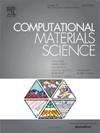ExaCA v2.0: A versatile, scalable, and performance portable cellular automata application for additive manufacturing solidification
IF 3.1
3区 材料科学
Q2 MATERIALS SCIENCE, MULTIDISCIPLINARY
引用次数: 0
Abstract
The previously established ExaCA software for performance portable alloy grain structure simulation has been updated to better represent the solidification behavior during complex alloy processing conditions, such as those encountered during metal additive manufacturing (AM), and for improved performance and scalability. An extension to the time–temperature history input data format and the core ExaCA algorithm to include an arbitrary number of melting and solidification events yielded improved prediction of texture for various melt pool geometries, expanding the range of AM-relevant conditions that can be accurately simulated. Improved heat transport process simulation coupling, including the creation of large raster datasets from single track time–temperature history data and in-memory coupling with the new, performance portable finite difference code Finch, were also demonstrated in example studies on the effect of multilayer AM microstructure predictions on hatch spacing and cell size, respectively. Additional new features are detailed and demonstrated, including the ability to perform simulations using various interfacial response function forms, execute simulations on state-of-the-art hardware, improved usability through post-processing versatility, and improved strong and weak scaling performance. The performance, physics, and versatility improvements demonstrated here will further enable large-scale studies on AM process–microstructure relationships that were not previously possible. Furthermore, the usability improvements and ability to run coupled AM process–microstructure simulations using the Finch-ExaCA workflow will facilitate broader use of this open-source software by the computational materials community.

求助全文
约1分钟内获得全文
求助全文
来源期刊

Computational Materials Science
工程技术-材料科学:综合
CiteScore
6.50
自引率
6.10%
发文量
665
审稿时长
26 days
期刊介绍:
The goal of Computational Materials Science is to report on results that provide new or unique insights into, or significantly expand our understanding of, the properties of materials or phenomena associated with their design, synthesis, processing, characterization, and utilization. To be relevant to the journal, the results should be applied or applicable to specific material systems that are discussed within the submission.
 求助内容:
求助内容: 应助结果提醒方式:
应助结果提醒方式:


